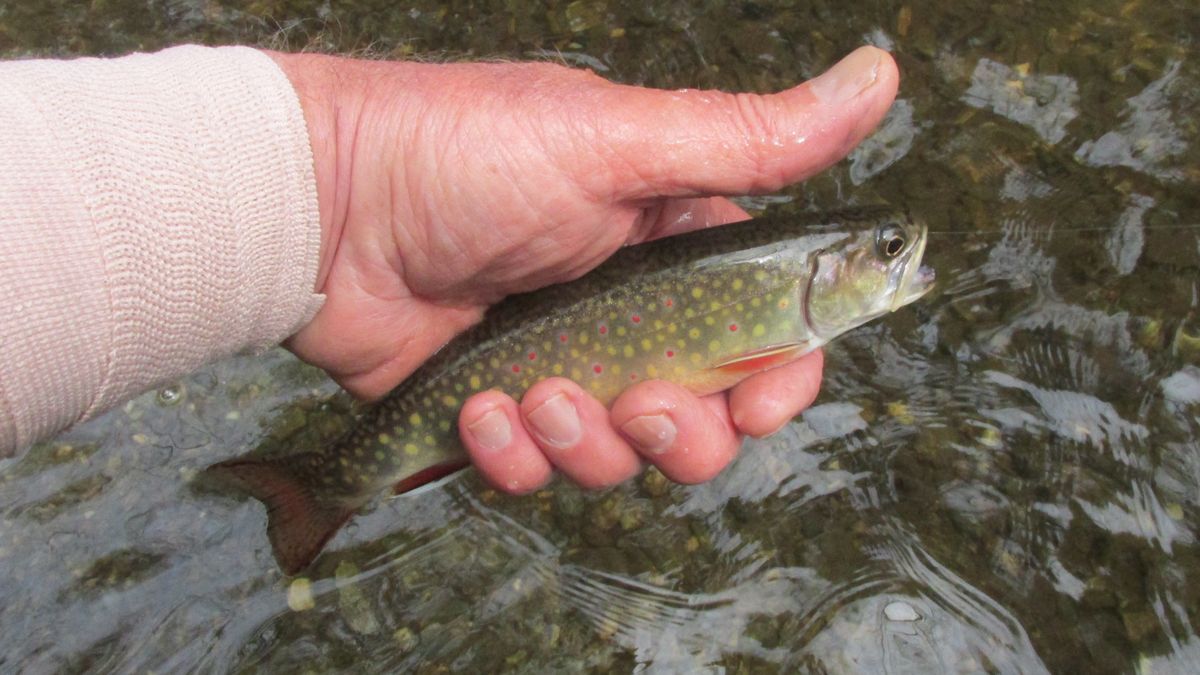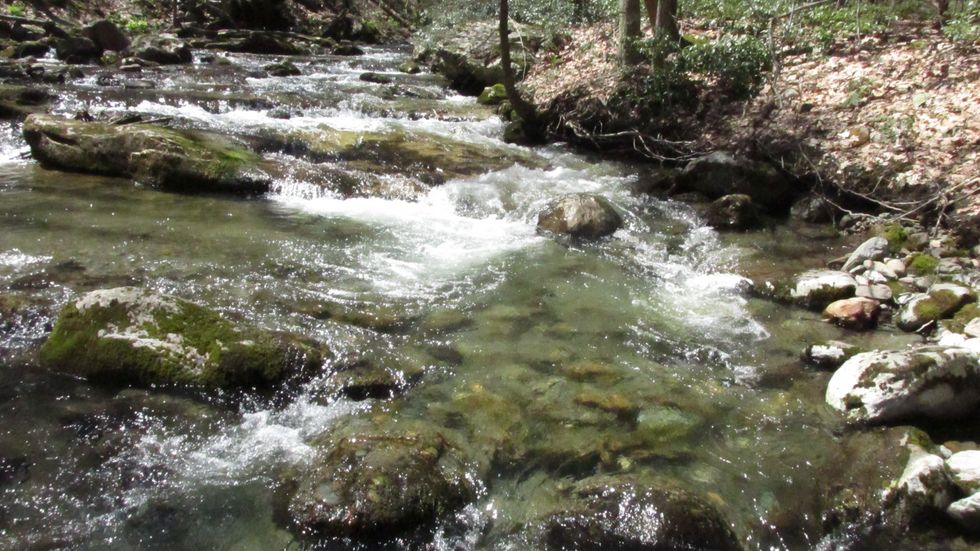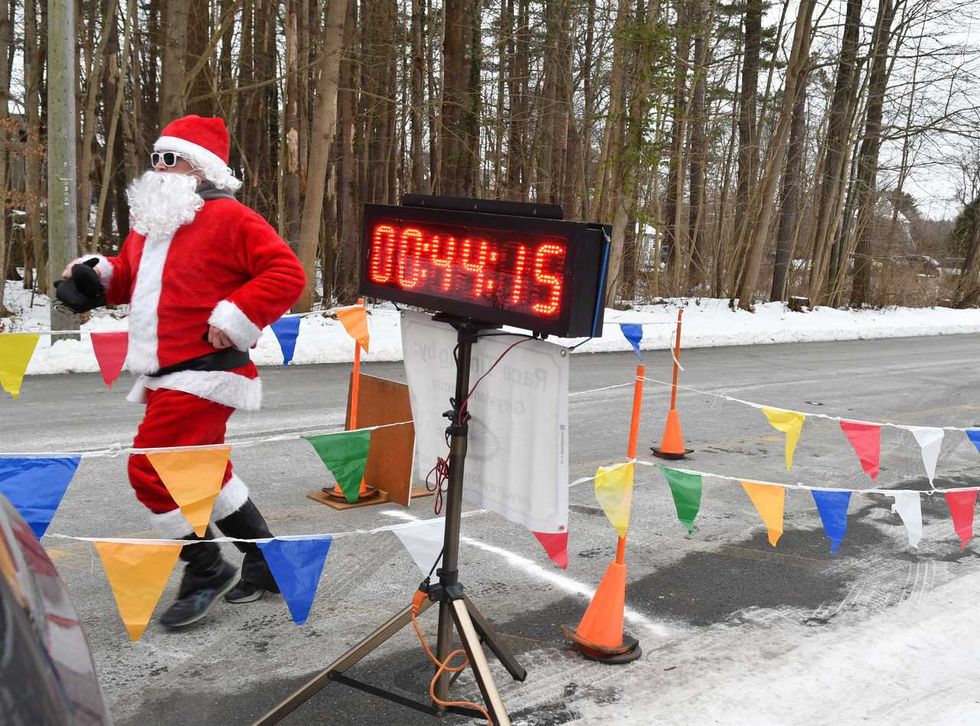Knees creak by wee creeks

First brookie of the day in hand.

First brookie of the day in hand.
This spring I have spent more time than usual creeping around the “little blue lines,” those streams that show up on good maps as, yes, little blue lines.
This is where to find wild trout. Often brook trout, occasionally browns or rainbows.
The first thing to do is get used to kneeling. The fish are generally aggressive, but they are also incredibly spooky.
Once they catch sight of an angler, or even a rod going back and forth, they will zoom off to their hidey holes and sulk.
If you don’t believe me, go to one of these streams and wade right on in. Watch as the little dark shapes whizz around.
When I was a callow youth of 45, kneeling was no big deal. At my advanced age, I have gone to knee pads, as worn by roofers and the fellows who restock potato chips at the grocery store. (It was one of the latter who kindly took his pads off and showed them to me.)
Reading the water is more important than ever in this context. What you want is “soft water.”
Imagine a pool that has a chute or plume of water coming in from above. As the faster-moving water enters the pool, it creates white water. On either side of the chute, there is calmer water. That’s soft water.
You’ll read about finding the seam. The seam is the line between slower and faster moving currents, or white water and soft water.
Trout like to hang around somewhere that offers protection from predators, not too much current to battle against, and adjacent to faster current, which brings food.
Finding the balance of these elements is what trout do all day, except once a year, when they have what passes for sex in the fish world.
It’s a depressing prospect for an ambitious fish, so don’t dwell on it.
So when approaching a likely pool, identify the different currents, areas of soft water, and the seams. Do this from a kneeling or crouching position, of course.

Now you have figured out where to stick the fly. Pausing briefly to savor the lower back pain, try a dry fly first. A bushy dry fly that floats well and that you can see.
Park it in the soft water. It will bounce around. Don’t let it sit more than a second or two. Flick it in, wait and flick it out.
Sometimes they’ll whack it right away. Other times they will want to see it a few times.
Next hit the seam. Sometimes it will disappear in the foam. Maybe it will sink. Don’t worry about it. Keep flicking.
When you do this often enough, you’ll get good at making miniscule adjustments from cast to cast. On big water, this is a matter of feet or a few inches. On a little blue line, it’s an inch or two tops.
None of these casts are going to be long. Use water loads, bow-and-arrow casts, even roll casts if you’re good at them. (I am not.)
You’re probably not going to be rearing back with a standard forehand cast too often. Not enough room, and no point to it either, since you’re sneaking around in kneepads and peering around boulders.
Whatever you do, don’t get stuck at one pool just because the big one flashed your fly but did not take it.
A good rule of thumb is: Show the fly to them six times. After that assume you are boring them, and move on.
When do you go subsurface? As usual, it depends.
One of my favorite tactics is to use a Chubby Chernobyl or any foam-bodied dry fly, really. It serves as an indicator 90% of the time.
I tie a piece of fluorocarbon tippet, usually 4X, to the bend of the dry fly hook with a clinch knot. The tippet piece is usually between one and two feet.
I start with a wet fly or an unweighted nymph. If that doesn’t work, I go to a brass beadhead nymph, which sinks some. And if that’s a bust, I go to a nymph with a tungsten bead that really sinks.
And if all that fails I cuss a bit and chuck a Wooly Bugger in there, just to show them who’s boss.
What rod to use?
I have a number of small stream rods, ranging in length from five and a half feet to eight feet, and in line weights from one to five.
More often than not I grab a Cabelas CGR six and a half foot four weight. It’s a slow action fiberglass rod, quite inexpensive. I have a discontinued CGR click and pawl reel for it, and a double tapered line.
For fixed line fishing in small streams my favorite is Dragontail’s Kaida, a zoom rod that fishes at nine feet and a bit, and 10 and a half feet. This is considerably longer than the fly rod, but the extra leverage allows me to keep most or all of the line and tippet off the water. The extra length is also helpful if I latch onto one of the little blue line Leviathans.
About that: Little blue line fishing is extra-crazy. You have to accept this.
After all, you are expending considerable energy in difficult terrain, performing a highly technical task, in pursuit of quarry you are not going to kill and eat.
And even if you did, a creel full of six-inch trout will yield only enough meat to cover a few Saltine crackers.
You wouldn’t be fishing for dinner, but for hors d’oeuvres.
Runners line up at the starting line alongside Santa before the start of the 5th Annual North Canaan Santa Chase 5K on Saturday, Dec. 13.
NORTH CANAAN — Forty-eight runners braved frigid temperatures to participate in the 5th Annual North Canaan Santa Chase 5K Road Race on Saturday, Dec. 13.
Michael Mills, 45, of Goshen, led the pack with a time of 19 minutes, 15-seconds, averaging a 6:12-per-mile pace. Mills won the race for the third time and said he stays in shape by running with his daughter, a freshman at Lakeview High School in Litchfield.

Don Green, 64, of Red Hook, New York, was second among male runners with a time of 21:17 and a 6:52-per-mile pace. Becky Wilkinson, 47, of Southfield, Massachusetts, was the first woman to cross the finish line with a time of 22:16, averaging a 7:11-per-mile pace. Wilkinson finished fourth overall.
Margaret Banker, 52, of Lakeville, finished second among women runners with a time of 23:59 and a 7:44-per-mile pace.
Runners came from all over Connecticut, Massachusetts and New York. One runner listed home as London, England. Many were members of the Run 169 Towns Society, a group that is dedicated to completing races in every one of Connecticut’s 169 towns. Elizabeth Smith, 32, of Manchester, a member of Run 169, said this was her 162nd town.
“I started 10 years ago,” Smith said. Her husband, Daniel, 33, has run races in 73 Connecticut towns, now including North Canaan. He was eager to know where to get a good cup of coffee after the race.
Santa, who got a head start on the group of runners but finished next to last with a time of 44:14, has been a feature in the North Canaan race since it started five years ago.
The 5K proceeds from a start in front of the North Canaan Elementary School on Pease Street to course around the Town Hall parking lot, up West Main Street past the transfer station to the state line and back. Cheryl Ambrosi, 45, of Danbury, was the last to cross the finish line with her dog Benji. “It was so much fun,” she said as she ended, even though she didn’t catch Santa.

The Torrington Transfer Station, where the Northwest Resource Recovery Authority plans to expand operations using a $350,000 state grant.
TORRINGTON — The Northwest Resource Recovery Authority, a public entity formed this year to preserve municipal control over trash and recycling services in northwest Connecticut, has been awarded $350,000 in grant funds to develop and expand its operations.
The funding comes from the Department of Energy and Environmental Protection via its Sustainable Materials Management grant program. It is intended to help the NRRA establish operations at the Torrington Transfer Station as well as support regional education, transportation, hauler registration and partnerships with other authorities.
Founded by the City of Torrington in May 2025, the NRRA was established to oversee regional municipal solid waste management. Its creation followed a $3.25 million offer by USA Waste & Recycling to purchase the Torrington Transfer Station — a sale that would have privatized trash services in the region.
The proposed sale was initially approved by the MIRA Dissolution Authority, the entity responsible for dissolving the state’s former Materials Innovation and Recycling Authority, which owned the Transfer Station at the time. Before the transaction could close, the state intervened and directed that the facility’s operating permit be assigned to the NRRA to preserve a publicly controlled alternative.
MIRA has since dissolved, and the Transfer Station is currently operated by the state Department of Administrative Services. Many towns in northwest Connecticut have expressed interest in joining the NRRA. As of December, Torrington and Goshen were the only two municipalities in the authority.
At the Dec. 11 meeting of the Northwest Hills Council of Governments (COG) — a regional planning body representing 21 municipalities in northwest Connecticut — Director of Community and Economic Development Rista Malanca encouraged more towns to sign on.
“We need towns to join the Northwest Resource Recovery Authority to show your support, show this is what you want to do,” Malanca said.
Salisbury First Selectman Curtis Rand said his municipality is planning a town meeting in January to vote on a resolution to join the NRRA. Cornwall’s Board of Selectmen recently discussed scheduling a town meeting in the winter for the same purpose. Sharon, Falls Village and North Canaan have also expressed continued interest in pursuing a public option.
Kent is the northernmost member of the Housatonic Resource Recovery Authority, a regional solid waste authority representing 14 municipalities stretching south to Ridgefield. COG towns expressed interest in joining HRRA in 2024, but they were denied and set out to develop the NRRA.
“We also have been having conversations with the Capital Region Council of Governments and the Naugatuck Valley Council of Governments to think about how we can use existing resources, maybe some of these grant funds, to bring in shared resources or shared staffing that will help with some of the recycling coordinating efforts,” Malanca said.
With grant funds secured, NRRA aims to grow to a point that it can take over operations at Torrington Transfer Station to serve as a regional hauling hub. What happens to the trash after that has yet to be determined. Currently, it is being shipped to a landfill out of state. The existing municipal refuse hauling contracts that were established with the state expire in 2027.
The Salisbury Winter Sports Association (SWSA) will host its annual Junior Jump Camp, a two-day introduction to ski jumping, on Saturday and Sunday, Dec. 27 and 28, from 9 a.m. to 2 p.m. at Satre Hill in Salisbury.
The camp is open to children ages 7 and up and focuses on teaching the basics of ski jumping, with an emphasis on safety, balance and control, using SWSA’s smallest hill. No prior experience is required.
The cost is $50 per child and includes instruction and lunch on both days. For more information or to register, visit www.skireg.com/swsa-camp or email info@jumpfest.org
Jesse Bunce, first selectman of North Canaan.
LITCHFIELD — The Northwest Hills Council of Governments welcomed six newly elected municipal leaders Thursday, Dec. 11, at its first meeting following the 2025 municipal elections.
The council — a regional planning body representing 21 towns in northwest Connecticut — coordinates transportation, emergency planning, housing, economic development and other shared municipal services.
Barkhamsted First Selectman Meaghan Cook, Goshen First Selectman Seth Breakell, Kent First Selectman Eric Epstein, Norfolk First Selectman Henry Tirrell, North Canaan First Selectman Jesse Bunce and Torrington Mayor Molly Spino were each elected to their post in November.
They filled the seats of their predecessors on the COG, who were each given a toast of appreciation: Nick Lukiwsky (Barkhamsted), Todd Carusillo (Goshen), Marty Lindenmeyer (Kent), Matt Riiska (Norfolk), Brian Ohler (North Canaan) and Elinor Carbone (Torrington).
COG Executive Director Rob Phillips said the outgoing members were given a going away mug that read “You’re living the dream still.” Members voted to appoint Warren First Selectman Greg LaCava to fill a vacancy on the Council’s Executive Committee. COG members voted by paper ballot, and LaCava defeated Burlington First Selectman Doug Thompson for the vacant seat.